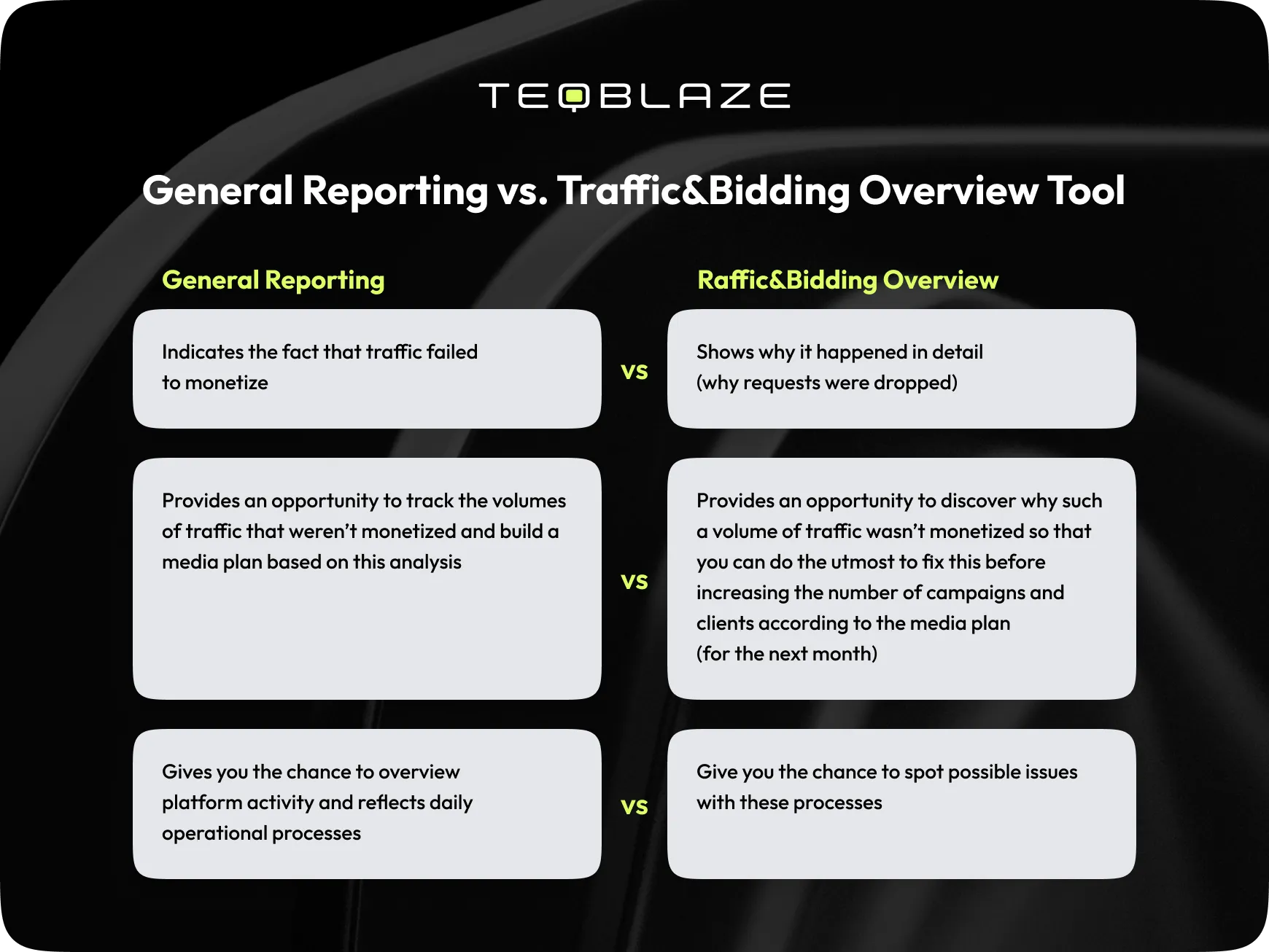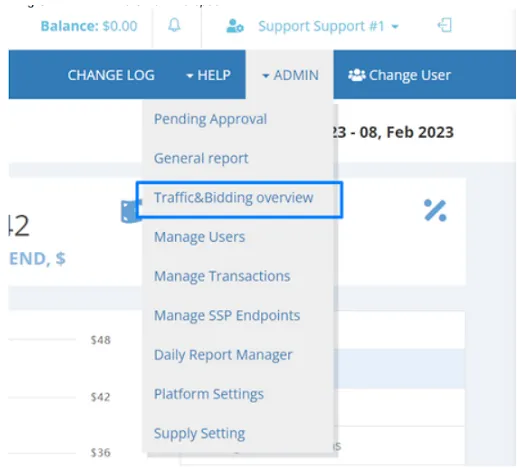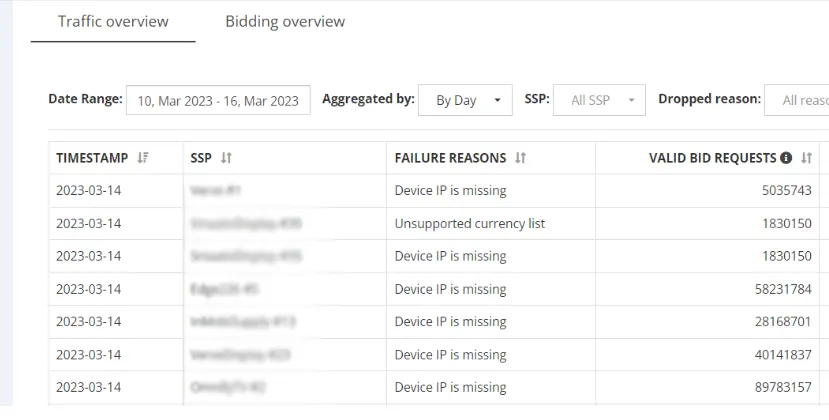Did you build your own DSP yet? Great, now it's time to start analyzing your white-label DSP's performance; assess the effectiveness of media buying and make informed decisions about optimizing your solution for better results. Ongoing analysis of the performance of an ad tech platform can lead to better results by identifying areas for improvement, refining strategies, optimizing ad inventory, and staying ahead of the competition.
In the last article, we discovered how a new release on TeqBlaze WL DSP makes your ad ecosystem stronger and smarter; in this article, we will focus on one of the core updates of this new release called “Traffic&Bidding Overview.” Today we’ll find out how this feature can be used to understand better your DSP’s performance and why it is so important for maximizing your ROI and profitability.
Correct platform operation is the main challenge of the new DSP owner
Being an owner of your own DSP means you have complete control over your ad tech platform, allowing you to offer programmatic advertising services to clients. More control means more opportunities to achieve success. However, more control also entails making the right business decisions.
As a platform owner, you will also have to build lasting relationships with clients willing to know how the platform performs and what they can achieve while advertising your solution. Impressive results reflected in remarkable numbers and stats will be an undeniable advantage for any kind of ad tech business owner, as it undeniably makes you a leader in the sphere and brings in more partners and clients willing to work with you.
After this, a solution becomes truly successful and gains a solid reputation, which naturally attracts more and more clients meaning that at some point, such a platform will need to scale.
At any stage of business development, you will need to ensure that your platform delivers results for your clients and partners. Making the right decisions is impossible without having a full picture in front of your eyes.
Why analyzing your DSP performance is important:
ROI. By analyzing the performance of your ad tech platform, you can determine which campaigns are generating the highest return on investment (ROI) and adjust advertising strategies accordingly. For example, 4% of the company’s ad budget can generate 25% of conversions. With insights that are actually backed by data, businesses can retain their existing ad budgets while achieving improvements of 10% to 30% (sometimes more) in performance;
Optimization. Analyzing the performance of your ad tech platform allows you to identify areas that need improvement and optimize your campaigns to achieve better results. For example, you may find that certain ad formats or targeting methods are not performing well, and you can adjust these settings to improve the effectiveness of campaigns;
Cost-effectiveness. Analyzing the performance of your ad tech platform can help you reduce wasted ad spend and increase the cost-effectiveness of your campaigns. By identifying which campaigns and targeting methods are not generating the desired results, you can stop investing in them and focus on more effective strategies;
Competitiveness. Analyzing the performance of your ad tech platform can also help you stay competitive in your industry. By staying up-to-date on the latest trends and technologies, you can continually improve your advertising strategy and stay ahead of your competition.
What areas should be checked first?
By analyzing key performance indicators (KPIs) such as click-through rates (CTR), conversion rates, and cost per acquisition (CPA), the owner can identify areas of the platform that are underperforming. For example, they may notice that the platform is dropping certain requests, which might be the most common cause of the problem.
By identifying these reasons, the owner can make changes to the platform, perform correct troubleshooting and get back to normal functioning. As a DSP owner, you also need to give the biggest attention to traffic and bidding analysis aspects of platform functioning. There are several reasons for this:
Optimize ad spend. By tracking traffic and bidding data, DSP owners can optimize their ad spend by identifying which ad placements and targeting options are performing best. This enables them to focus their ad spend on the most effective channels, increasing the chances of reaching their target audience and achieving their advertising goals;
Improve targeting. By analyzing traffic and bidding data, DSP owners can identify patterns and trends in user behavior, allowing them to refine their targeting strategies. This can help them to serve ads to users who are most likely to engage with their ads and take the desired action, leading to better campaign performance;
Enhance ROI. DSP owners can improve their return on investment (ROI) by tracking traffic and bidding data. By identifying which ad placements are generating the most conversions and revenue, they can adjust their bidding strategies to prioritize these placements, resulting in higher revenue and a better ROI;
Identify fraud. Tracking traffic and bidding data can help DSP owners detect fraudulent activity such as ad fraud, click fraud, and impression fraud. By monitoring traffic and bidding patterns, they can identify anomalies and take action to prevent fraudulent activity, protecting their advertisers' budgets and ensuring campaign performance.
How to do it on your platform?
The most important advice that can be given at this point is to collect and analyze data on a regular basis to evaluate your platform's performance. Use analytics tools to track your KPIs and identify trends, patterns, and areas for improvement.
Most DSP platforms offer reporting tools that allow you to view detailed performance data for your campaigns. However, not all WL DSPs are equal - while many of them let you inspect the issues in detail, only some of them let you dig deeper to understand the reasons that triggered those issues.
Thus, it is very important to ensure that the technology you select for your business has all functionalities for timely analysis and reporting. Plus, such a report should let you track the reasons why certain problems occur. These tools can help you identify trends and patterns that could indicate issues with bidding. Many WL DSP platforms like TeqBlaze offer tools to help you identify these issues. Tools like Traffic&Bidding Overview tool can save your time by quickly pinpointing the source of the problem.
For example, here you can compare the general reporting with in-deep analysis that WL DSP can provide (Traffic&Bidding Overview tool):

Real-time analytics capabilities should be able to analyze terabytes of data and hundreds of variables in real time. With all the necessary performance data, businesses can create a comprehensive picture of their platform performance, run scenarios, and adjust ad strategy on the fly.
Traffic&Bidding overview from TeqBlaze
TeqBlaze has recently introduced a very valuable analytics tool for while-label DSP called Traffic&Bidding Overview. You can find it under the Admin dropdown in your WL DSP platform:

It allows platform owners easily identify why their DSP may drop ad requests. This innovative tool provides a clear understanding of the precise reasons for declined traffic, saving you valuable time and effort that would otherwise be spent sifting through reports.
With the Traffic&Bidding Overview tool, you no longer need to rely solely on your account manager for assistance, as this specially-designed tool can track and diagnose a range of potential issues. Through its advanced features, you will be able to quickly identify the causes of declined traffic, enabling you to make any necessary adjustments and optimize your ad campaigns for maximum success:
The tool can identify that the request missed a mandatory parameters.
The tool pinpoints the reasons why requests were dropped on the Campaign or Creative levels. Even if the request is valid, it may still be dropped due to particular creative or campaign settings:

For example, the screenshot above indicates that some of the Bid Requests were dropped due to the reason “Device IP is missing." It means the request doesn’t contain one of the mandatory parameters — IP address.
You will be able to identify the reasons why requests might be invalid.
Alternatively, the requests may be valid, but they don’t come through because of certain settings of each Campaign/Creative. As a result, even if the request is valid, it may still be dropped for some particular Campaigns/Creatives.
The Bid request may be dropped due to the reason “Blocked by Filter List Manager” which means that the whitelist or blacklist for Domains/Bundles and so on has been created.
After finding out the reason, you will be able to take action to fix the issue by adjusting your installed filter lists, geo-targeting settings, spending limit per campaign, and more. If the reason for dropped requests are missing parameters, you will be able to take action timely by contacting your partners and notifying them about the problem.
How can this all be useful to WL DSP owners?
One of the benefits of the Traffic&Bidding Overview feature is that it allows white-label DSP owners to see a breakdown of campaign performance by different targeting criteria. This includes data on the performance of campaigns by device type, location, and other demographic factors.
With a detailed list of potential issues, DSP owners can easily find the cause of the problem and make adjustments to optimize their ad campaigns for maximum success. Instead of having to search for potential issues in the reports, the tool enables them to quickly spot the issues in one place and then troubleshoot them as quickly as possible.
The Traffic&Bidding Overview feature also includes real-time bidding information, allowing white-label DSP owners to monitor and adjust their bidding strategies as needed. By understanding what is a white-label DSP and how different bidding strategies perform, white-label DSP owners can adjust them to achieve better campaign results.
The Traffic and Bidding Overview feature of the DSP platform provides significant business value for its owners. By using this feature, DSP owners can:
Troubleshoot their Campaign bidding, identify why requests are dropped, and make necessary adjustments to their filter lists, Campaigns, and Creatives.
Ensure that they are effectively targeting the right audience, which leads to a higher conversion rate and better ROI.
Make informed decisions about the filter lists, SSP partners, and ad formats they work with, which can improve their efficiency and effectiveness in delivering advertising campaigns.
Moreover, the Traffic and Bidding Overview feature helps DSP owners to enhance their relationships with their supply partners. By identifying the reasons why requests are dropped, they can inform their SSP partners and work collaboratively to resolve any issues that may arise. This, in turn, can lead to better partnerships, increased trust, and more effective ad delivery.
The bottom line
The access to relevant and high-quality performance data allows your team to analyze advertising data to gain valuable insights efficiently. Businesses can significantly improve their overall performance by relying on data-based insights instead of guesswork.
The DSP owner can use the data gathered from performance analysis to test different advertising strategies. For example, they can experiment with various advertising strategies and refine them based on what works best. Most importantly, platform owners should be aware of all possible bidding issues and aptly troubleshoot them when problems arise.
This process of ongoing testing and refinement can lead to continuous improvement of the platform's performance. The Traffic&Bidding Overview feature is an essential tool that helps WL DSP owners to ensure this process. It provides a comprehensive overview of campaign performance, including breakdowns by different targeting criteria and real-time bidding information. Thus, as a platform owner, you can always make informed decisions on campaign optimization and bidding strategies, which will lead to better campaign results and increased revenue.
Unlock new opportunities in your White Label DSP to optimize your ad campaigns and drive better results for your business.

 Nadiia Hrabivska
Nadiia Hrabivska




